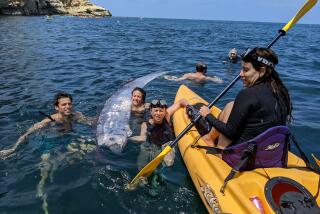Fish on boat set adrift by Japan tsunami land in U.S.
- Share via
SEATTLE — Since a tsunami struck Japan more than two years ago, a variety of debris has washed up on U.S. beaches — including large boat docks and a soccer ball, found in Washington state’s Olympic National Park, from the Otsuchi Soccer Club.
That all got trumped recently with the discovery of six live fish, stowed away in a water-filled bait box aboard a 20-foot Japanese boat that washed up on the Long Beach Peninsula in southwestern Washington.
Researchers had already seen live crabs, sea stars and algae clinging to parts of the estimated 1.5 million tons of debris unleashed by the March 2011 tsunami, but they had never encountered live fish that drifted on their own from Asia, said John Chapman, who specializes in aquatic biological invasions at Oregon State University’s Hatfield Marine Science Center.
“This comes out there on the far end of the bell curve, I think,” Chapman told the Los Angeles Times. “We know that it does happen that things disperse like that, but it’s on a million-year scale, not within a century or anything like that.”
Five of the fish were euthanized to prevent the introduction of a new invasive species along the West Coast; the other is on display at the Seaside Aquarium in Seaside, Ore.
Aquarium curator Keith Chandler said he was called to City Hall in nearby Long Beach, Wash., not long after the boat washed up in late March and shown the surviving fish -- known popularly as striped beakfish or a barred parrotfish -- swimming in a bucket.
“They didn’t want to let this fish go, and they didn’t want to let it die. They didn’t know what to do with it,” Chandler said in an interview.
“So we decided to put it on display, where people can take a look at this long-distance traveler.”
The semitropical, reef-dwelling fish is a popular food item in Japan. Chapman said it’s not clear how the fish made it across the ocean.
Certainly they weren’t trapped in the bait box the whole time, he said. More likely, the small, dinghy-like boat was partially submerged for most of the voyage, and the fish swam in and out of the box for shelter.
“They likely lived associated with the boat for two years,” he said.
That raises the question of how many other fish were also drifting with the boat and didn’t wash ashore with it -- suggesting that there may have been other living creatures arriving on the U.S. coast with the tsunami debris that swam away before their host vehicles landed.
“We do wonder what’s disappearing before it comes to shore,” Chapman said.
Chandler said he was surprised to see the fish survive a voyage in water much colder than that to which they’re accustomed. “But I guess they had two years to acclimate” he said.
ALSO:
Kansas latest state poised to restrict abortion
Tears for a hound? Texas Supreme Court is unmoved
Trayvon Martin’s family reportedly settles wrongful-death claim
More to Read
Sign up for Essential California
The most important California stories and recommendations in your inbox every morning.
You may occasionally receive promotional content from the Los Angeles Times.










